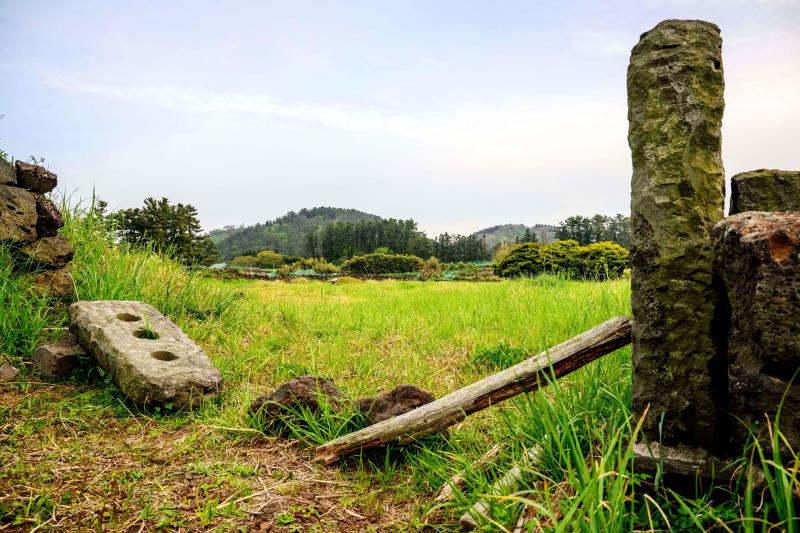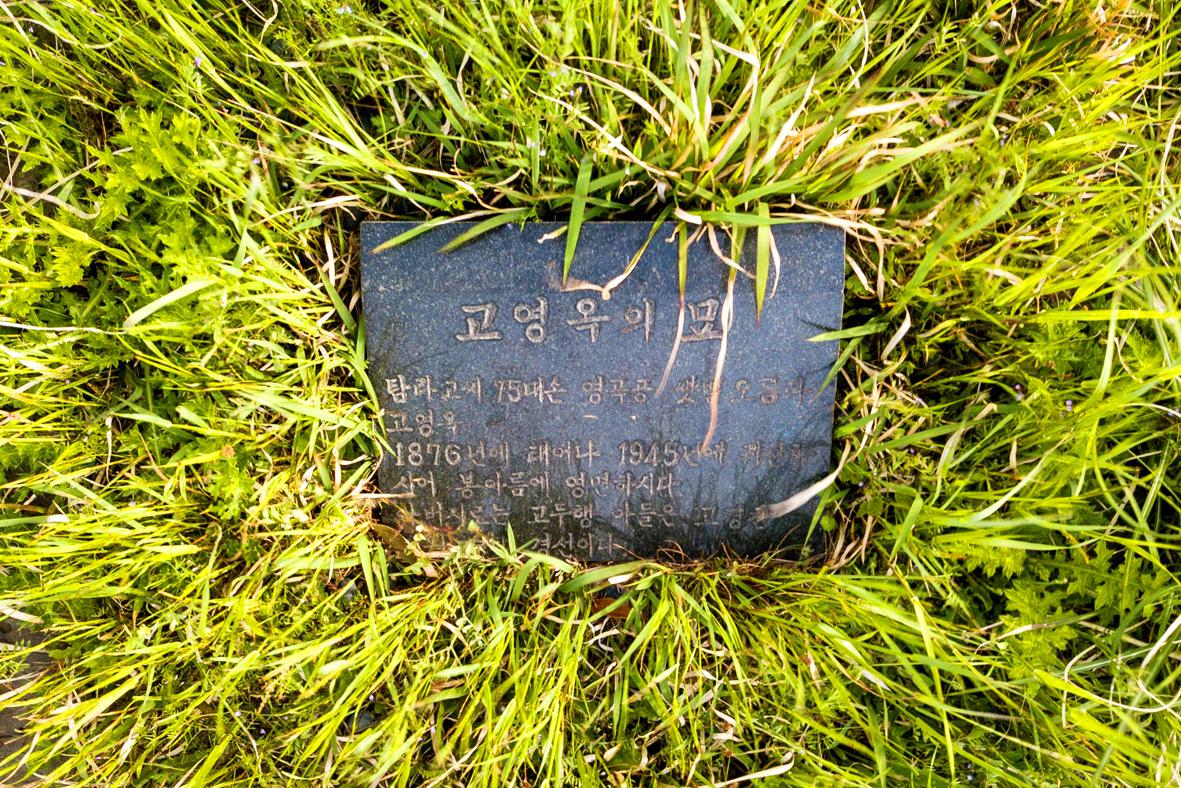North Korea’s leader Kim Jong-un has threatened Seoul with fiery destruction, but as a remote graveyard on a resort island shows, he has closer links to the South than he might like to admit.
At a cemetery in a hard-to-find corner of South Korea’s Jeju island, there are 13 tombstones bearing the Ko family name — Kim’s relatives through his mother, Ko Yong-hui.
Jong-un is the third member of the Kim family to rule North Korea, following in the footsteps of his father and grandfather — what official hagiography calls the “Paektu bloodline.”

Photo: AFP
But the Jeju graves tell a wider story.
Kim’s mother was born in Osaka in 1952 to a native Jeju islander who emigrated to Japan in 1929, when the Korean peninsula was under Tokyo’s colonial rule.
Many of her family, including Kim’s maternal great-grandfather, are buried on Jeju, their overgrown graves a stark contrast to Pyongyang’s Kumsusan Palace of the Sun, where the embalmed bodies of Kim’s father and grandfather Kim Il-sung lie in state.

Photo: AFP
After Kim came to power in 2011 following the death of his father Kim Jong-il, many experts highlighted his mother’s South Korean and Japanese heritage. Pyongyang has never confirmed it.
The regime “must have feared confirmation would undermine its legitimacy,” said Cheong Seong-chang of the Center for North Korea Studies at the Sejong Institute.
The Kim dynasty bases its claim to power on Kim Il-sung’s role as a guerrilla fighter driving out Japan and winning Korea its independence in 1945.
“Korea-Japan heritage runs directly counter to the North Korean myth of its leadership,” Cheong said.
KIM’S MOTHER
Kim’s mother grew up in the Japanese port city of Osaka, but her family moved to North Korea in the 1960s as part of a decades-long repatriation program by Pyongyang.
The scheme urged ethnic Koreans living in Japan to move to North Korea, part of a drive to “claim supremacy” over the South, said Park Chul-hyun, a novelist and columnist in Tokyo.
“The North saw the Korean-Japanese community as a strategic battleground,” he said, and managed to convince nearly 100,000 ethnic Koreans to relocate to the “socialist paradise.”
The Ko family answered the call, and lived a relatively normal life in the North until their eldest daughter caught the eye of the country’s heir apparent.
Experts believe that Ko, who was a performer with the Mansudae Art Troupe of musicians and dancers, first met Kim Jong-il in Pyongyang in 1972.
She would become his partner in 1975, experts say, and although there is no official record of their marriage the pair had three children. She died in 2004.
“There has been nothing about Ko Yong-hui in official state media,” said Rachel Min-young Lee, a non-resident fellow with the 38 North Program at the Washington-based Stimson Center.
There is not much in state media about Kim Jong-un’s background and heritage generally beyond attempts to show he is the legitimate heir to the Mount Paektu legacy, she added.
EMPTY GRAVE
South Korean media discovered the Ko family graves on Jeju in 2014 — one of the first real confirmations of Kim Jong-un’s South Korean ancestry.
At that time, there was a plaque — known as an “empty grave” in the South — honoring Kim’s maternal grandfather Ko Gyong-taek, even though he died and was buried in the North.
“Born in 1913 and moved to Japan in 1929. He passed away in 1999,” read the plaque, a custom which allows family members to perform ancestor rites even if the body is not present.
The plaque was not there when AFP visited the Jeju graveyard in April.
It had been removed by a distant relative of Kim Jong-un, who was shocked by the media attention and feared the grave would be vandalized, the daily Chosun Ilbo reported.
He said his family “knew nothing about the relation to Kim Jong-un”, prior to the media discovery, the report said.

Nine Taiwanese nervously stand on an observation platform at Tokyo’s Haneda International Airport. It’s 9:20am on March 27, 1968, and they are awaiting the arrival of Liu Wen-ching (柳文卿), who is about to be deported back to Taiwan where he faces possible execution for his independence activities. As he is removed from a minibus, a tenth activist, Dai Tian-chao (戴天昭), jumps out of his hiding place and attacks the immigration officials — the nine other activists in tow — while urging Liu to make a run for it. But he’s pinned to the ground. Amid the commotion, Liu tries to

The slashing of the government’s proposed budget by the two China-aligned parties in the legislature, the Chinese Nationalist Party (KMT) and Taiwan People’s Party (TPP), has apparently resulted in blowback from the US. On the recent junket to US President Donald Trump’s inauguration, KMT legislators reported that they were confronted by US officials and congressmen angered at the cuts to the defense budget. The United Daily News (UDN), the longtime KMT party paper, now KMT-aligned media, responded to US anger by blaming the foreign media. Its regular column, the Cold Eye Collection (冷眼集), attacked the international media last month in

A pig’s head sits atop a shelf, tufts of blonde hair sprouting from its taut scalp. Opposite, its chalky, wrinkled heart glows red in a bubbling vat of liquid, locks of thick dark hair and teeth scattered below. A giant screen shows the pig draped in a hospital gown. Is it dead? A surgeon inserts human teeth implants, then hair implants — beautifying the horrifyingly human-like animal. Chang Chen-shen (張辰申) calls Incarnation Project: Deviation Lovers “a satirical self-criticism, a critique on the fact that throughout our lives we’ve been instilled with ideas and things that don’t belong to us.” Chang

Feb. 10 to Feb. 16 More than three decades after penning the iconic High Green Mountains (高山青), a frail Teng Yu-ping (鄧禹平) finally visited the verdant peaks and blue streams of Alishan described in the lyrics. Often mistaken as an indigenous folk song, it was actually created in 1949 by Chinese filmmakers while shooting a scene for the movie Happenings in Alishan (阿里山風雲) in Taipei’s Beitou District (北投), recounts director Chang Ying (張英) in the 1999 book, Chang Ying’s Contributions to Taiwanese Cinema and Theater (打鑼三響包得行: 張英對台灣影劇的貢獻). The team was meant to return to China after filming, but